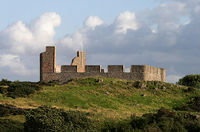Annotation:Hume Castle (2): Difference between revisions
m Text replace - "[[{{BASEPAGENAME}}|Tune properties and standard notation]]" to "'''Back to [[{{BASEPAGENAME}}]]'''" |
m Text replacement - "garamond, serif" to "sans-serif" |
||
| Line 1: | Line 1: | ||
'''Back to [[{{BASEPAGENAME}}]]''' | '''Back to [[{{BASEPAGENAME}}]]''' | ||
---- | ---- | ||
<p><font face=" | <p><font face="sans-serif" size="4"> | ||
'''HUME CASTLE'''. Scottish, Reel. G Major. Standard tuning (fiddle). John Glen (1891) finds the earliest printing in Daniel Dow's (1732-83) '''A Collection of Ancient Scots Music for the Violin, Harpsichord, or German Flute never before printed''' (1775, Edinburgh, p. 20). A tune called "Hume Castle" also appears in the Thomas Calvert Collection of 1799. Calvert was a musician from Kelso, Scotland (near Hume), and a note with the collection states that Calvert supplied "a variety of music and instruments, instruments lent out, tun'd and repaired." Hume Castle was once the seat of the Hume/Home family, and the original structure dates from the 13th century. The medieval building was destroyed by Cromwell's artillery in 1651. In 1794 the Earl of Marchmont built a new castle on the same foundations, however, it appears that it was never completed (or only meant for show) and remained only a shell that may be seen today from Marchmont and other points in the border region between Scotland and England. The castle site commands exquisite views and was used as a lookout and beacon station from the Napoleonic Wars through World War II. | '''HUME CASTLE'''. Scottish, Reel. G Major. Standard tuning (fiddle). John Glen (1891) finds the earliest printing in Daniel Dow's (1732-83) '''A Collection of Ancient Scots Music for the Violin, Harpsichord, or German Flute never before printed''' (1775, Edinburgh, p. 20). A tune called "Hume Castle" also appears in the Thomas Calvert Collection of 1799. Calvert was a musician from Kelso, Scotland (near Hume), and a note with the collection states that Calvert supplied "a variety of music and instruments, instruments lent out, tun'd and repaired." Hume Castle was once the seat of the Hume/Home family, and the original structure dates from the 13th century. The medieval building was destroyed by Cromwell's artillery in 1651. In 1794 the Earl of Marchmont built a new castle on the same foundations, however, it appears that it was never completed (or only meant for show) and remained only a shell that may be seen today from Marchmont and other points in the border region between Scotland and England. The castle site commands exquisite views and was used as a lookout and beacon station from the Napoleonic Wars through World War II. | ||
[[File:hume.jpg|200px|thumb|left|Viewed in evening light from Hume Craigs. | [[File:hume.jpg|200px|thumb|left|Viewed in evening light from Hume Craigs. | ||
| Line 9: | Line 9: | ||
<br> | <br> | ||
</font></p> | </font></p> | ||
<p><font face=" | <p><font face="sans-serif" size="4"> | ||
''Source for notated version'': | ''Source for notated version'': | ||
<br> | <br> | ||
<br> | <br> | ||
</font></p> | </font></p> | ||
<p><font face=" | <p><font face="sans-serif" size="4"> | ||
''Printed sources'': | ''Printed sources'': | ||
<br> | <br> | ||
<br> | <br> | ||
</font></p> | </font></p> | ||
<p><font face=" | <p><font face="sans-serif" size="4"> | ||
''Recorded sources'': <font color=teal></font> | ''Recorded sources'': <font color=teal></font> | ||
</font></p> | </font></p> | ||
Revision as of 13:25, 6 May 2019
Back to Hume Castle (2)
HUME CASTLE. Scottish, Reel. G Major. Standard tuning (fiddle). John Glen (1891) finds the earliest printing in Daniel Dow's (1732-83) A Collection of Ancient Scots Music for the Violin, Harpsichord, or German Flute never before printed (1775, Edinburgh, p. 20). A tune called "Hume Castle" also appears in the Thomas Calvert Collection of 1799. Calvert was a musician from Kelso, Scotland (near Hume), and a note with the collection states that Calvert supplied "a variety of music and instruments, instruments lent out, tun'd and repaired." Hume Castle was once the seat of the Hume/Home family, and the original structure dates from the 13th century. The medieval building was destroyed by Cromwell's artillery in 1651. In 1794 the Earl of Marchmont built a new castle on the same foundations, however, it appears that it was never completed (or only meant for show) and remained only a shell that may be seen today from Marchmont and other points in the border region between Scotland and England. The castle site commands exquisite views and was used as a lookout and beacon station from the Napoleonic Wars through World War II.

Source for notated version:
Printed sources:
Recorded sources:
Back to Hume Castle (2)
